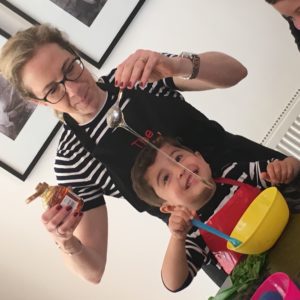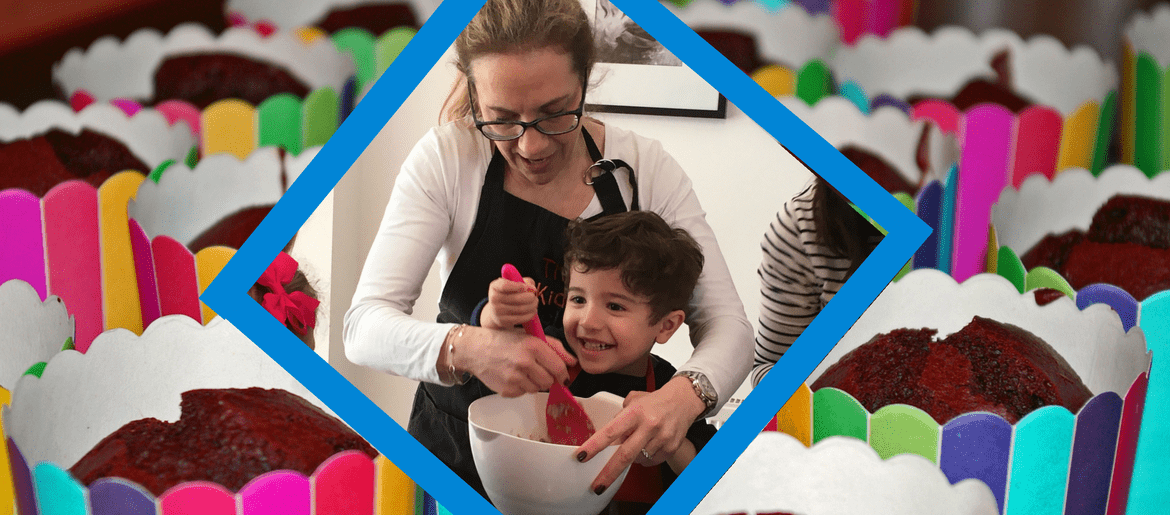Nicole Freeman always had a love of food and cooking. But it was her own fussy eater that prompted her to set up The Kids’ Kitchen, her multi-award-winning cookery school for kids.
She aims to show kids how much fun cooking can be, and encourage them to try new foods, by involving them in preparing and cooking their own meals.
Here she explains why the effects of sugar on child health may not be as bad as you think…
Why sugar isn’t necessarily the enemy for your kids, but you might be
Wow. That’s a confrontational headline, but I got your attention. Now let me explain.
I am not advocating a raid on the secret sweetie stash (we’ve all got one). Nor am I recommending a fizzy drink fest. On the contrary, I TOTALLY believe in home-cooked “real” food.
I am, no doubt as you are, worried about our society’s increasing reliance on ready meals and what this means for our kids’ generation in terms of obesity, tooth decay and all kinds of other future health issues. But I don’t believe that being the sugar police is helpful either.
How to avoid the sugar “battle-ground”
If you’ve ever been on a diet, and I am guessing that most of us have been, what’s always on your mind? Yup. All those foods you can’t eat. Can’t eat carbs, cake and cheese? What are you craving? You guessed it.
Well, surprise surprise, kids are no different. If you ban cakes, sweets and chocolates, that’s what they want and it can quickly become a battle-ground especially if their friends are allowed these things. And if you make a “healthy alternative” with all the coconut oil, nuts, goji berries and other superfoods of the moment, let’s be honest, it doesn’t taste like the real thing and the kids will just feel cheated. What’s more, you can pack your bakes with honey, agave or maple syrup which are admittedly less refined, but sugar is sugar in terms of what the body does with it and the ultimate health implications.
I’ve lost count of the number of birthday parties I have gone to where kids “denied” cake are sitting under the table stuffing their faces while they have half a chance. Which is why I believe in that old fashioned maxim – everything in moderation.
Everything in moderation
A little of what you fancy does you good. Remember, when it comes to kids and food it’s our job to teach them that no foods are “banned” or “bad”. Labelling food can have all kinds of longer term implications. This can result in kids eating more of the “bad” foods than if everything was on offer and we taught them how to make healthy choices.
We need to help our kids to understand that:
- They should stock up on foods that are healthy for their bodies (proteins, fruit, veg, carbs etc.) and eat other foods in moderation (sweet treats);
- Food is a sociable pleasure. Exclusion diets aren’t pleasurable or often sociable, as it makes it hard to eat out or with friends;
- They should try to broaden their palate and expand what they eat. (If you have a fussy eater you will know how important this is!)
Keep an open mind
Being open minded and experimenting is key. If we ban and label foods, which is what we are doing when we demonise sugar and produce supposedly “healthy” alternatives, then we aren’t teaching our kids self-regulation around food. They need to regulate both what they eat and how much they eat and we need to trust our kids to make their own food choices.

Nicole in action at The Kids’ Kitchen
Start by changing behaviour
One of my key mantras is to change the behaviour first. We should be encouraging our kids to try a wide range of foods and if that means sometimes introducing ingredients in a “sweet” context (see my chocolate beetroot cake recipe below, for example) then I am all for that as a first step.
That way I’m showing kids that cooking (and eating) can be fun. I’m using new ingredients and challenging the “I don’t like it” brigade. And for those fussiest of fussy eaters, I’m getting them to touch, smell, even taste and so involving all their senses, which is the first (slow) step to introducing new foods.
Time to bake
So, set aside a little time to bake with the kids and do try out my chocolate beetroot cake recipe. It’s a fab introduction to the earthy sweetness of beetroot. It’s a fun “game” when you watch the cake mix going in pink and coming out brown, and you challenge people to guess your secret ingredient. Plus there’s all the toilet humour potential of beetroot (more about this below) which is always a winner with kids!
Chocolate beetroot cake
Makes 24 mini muffins
A great way to introduce kids to beetroot – both taste-wise and toilet-humour wise! Don’t worry if the kids’ wee and poo go pink. This is called beeturia and happens because the pink colour of the beetroot isn’t broken down in your stomach when you digest the food.
If you are buying bunched beetroot, keep the stalks for “painting” or cut the beetroot in half and use like you would for potato printing which is a great hands-on craft activity. You can also use the beetroot to give your lips a natural “stain”.
Ingredients
40g cocoa powder
90g self raising flour
90g caster sugar
125g cooked beetroot (roast yourself or use pre-cooked packets, though not the stuff sold in vinegar)
2 eggs
100ml sunflower oil
1 tsp vanilla extract
Method
- If you are roasting the beetroot, peel, cut into quarters/chunks, drizzle with a small bit of oil and roast at 200C for 30+ minutes until soft and going brown at the edges. This will depend on the size of your beetroot pieces.
- Tip: your hands will go bright pink which is fun, but if you don’t want to look like you just killed someone with your bare hands, wear a pair of rubber gloves when peeling.
- Puree the beetroot in a food processor.
- Slowly add the eggs, vanilla and oil and whizz until smooth. The mixture will look bright pink.
- Now add in the cocoa, flour, sugar and baking powder and whizz again.
- Pour into the mini muffin tins.
- Bake at 180C/ fan 160C for about 15 mins until a skewer comes out clean.
- Tip: to teach your kids about natural food colours, you can even make an icing for the cake by mixing some beetroot juice (or just use the bowl you’ve put the roasted beetroot in) with some icing sugar and water until you have a spreadable paste.
So I hope I’ve convinced you that sugar isn’t the big baddie all the time and that using it judiciously can introduce kids to new ingredients they might not otherwise try. By teaching kids about ALL different types of food and the concept of moderation, we set them up for a long term healthy relationship with food which is, after all, what we all want.

The Kids’ Kitchen
About The Kids’ Kitchen
Nicole has been featured on Sky News and in many publications and books. She is currently developing an online course to help support families through their mealtime struggles. You can find out more and get tips, recipes and advice on her Family Foodies Page and check out what kids can really get up to in the kitchen at The Kids’ Kitchen cookery school or contact her via Facebook.
Find The Kids’ Kitchen classes near you on Happity.
Happity is powered by a team of remote- and flexibly-working parents. Visit Happity to find baby groups and toddler activities near you.
Find out more about the Happity story or sign up for our newsletter.


0 Comments